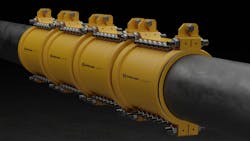ADIPEC 2024: Extending the life of subsea pipelines is a sustainable solution for the future
By Adrian Gamman, Norclamp
Across the globe, thousands of miles of subsea pipelines, many of which were installed during the 1970s and 1980s, are reaching the end of their operational lifespans. The financial burden of replacing these pipelines, especially subsea pipelines, has driven many operators to seek alternative solutions that allow them to maintain, repair and extend the life of an aging pipeline network in a way that minimizes both costs and environmental risks.
Because when pipelines fail, the consequences are severe; leaks, spills, and ruptures can lead to environmental disasters, costly downtime and regulatory violations. Extending the life of pipelines without compromising safety or operational efficiency has long been a complicated issue. The most promising strategy to successfully extend the life of aging pipelines is a focus on preservation and enhancement rather than replacement.
In particular, solutions that can repair and reinforce existing pipelines are vital to ensuring the continued safety of operations. By preserving and strengthening these critical assets, costly infrastructure overhauls can be avoided while reducing the operational risks associated with aging infrastructure.
In addition, replacing pipelines may not be the best solution when we consider the broader environmental and economic implications. Replacing pipelines on a massive scale would require a significant amount of steel, energy and resources—further contributing to the industry’s emissions and environmental impact. As the industry moves toward ambitious climate targets, including net zero by 2050, it is clear that operators and service companies need to rethink how they approach the problem of aging infrastructure.
Technological advancements for pipeline maintenance
Across the industry, there is an increased use of solutions that allow operators to avoid full pipeline replacements. From advanced corrosion inhibitors to smart pipeline monitoring systems, the industry is increasingly focused on solutions that allow pipelines to be safely and efficiently maintained for longer periods.
The Infinity Clamp, a new product released in August from Norclamp, is designed to address the challenges of corrosion and mechanical degradation in subsea pipelines. It represents a critical advancement in how the operational lifespan of subsea pipelines can be extended with minimal environmental impact. Unlike full-scale replacements, the clamp allows operators to address specific sections of damaged pipelines without the need for massive disruption to production. It offers a way to manage pipeline integrity in a cost-effective and more sustainable way, all while allowing operators to avoid the emissions associated with new pipeline construction.
A cultural shift is required
As the oil and gas sector continues to navigate the challenges of aging pipelines, the need for effective solutions has never been more pressing. The good news is the industry is already taking steps in the right direction. Ultimately, the future of the oil and gas industry lies in its ability to innovate and adapt. The days of “build and forget” need to be in the past. This will require a cultural shift within the industry to prioritize sustainability, safety and long-term asset management over short-term solutions.
By embracing solutions that focus on the preservation of existing infrastructure, the industry can reduce costs, mitigate environmental risks and contribute to a more sustainable energy future. The key to success will be in the industry's ability to recognize that aging infrastructure is not always a problem to be solved by replacement alone, but a challenge that can be solved with smarter, more sustainable solutions.
IK Group business areas include Izomax, IK Subsea, IK Trax and Norclamp. IK Group is exhibiting in Hall 8 at booth 8970 at the ADIPEC Exhibition and Conference this week in Abu Dhabi, UAE.
About the Author

Adrian Gamman
Adrian Gamman is the vice president of IK Subsea and chairman of the board with Norclamp.
With more than a decade of experience in the oil and gas industry, Gamman specializes in the subsea sector.
He earned an MSc in industrial economics from NMBU in 2012 and commenced his career at Nemo Engineering (later acquired by Kongsberg in 2015) as a project engineer/manager. Joining IK-Group in 2015 as a project manager, he has successfully overseen some of the company's most significant and challenging projects. Recognized for his valuable contributions, he ascended to the role of subsea manager in 2020, subsequently being promoted to the role of vice president of subsea.
